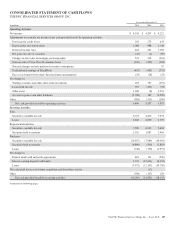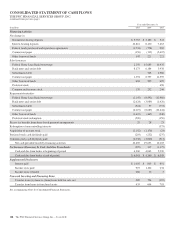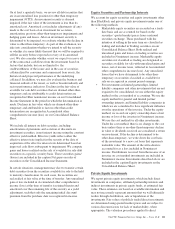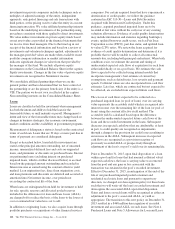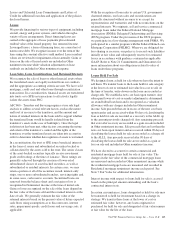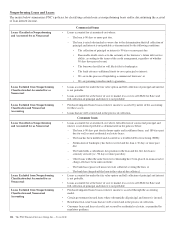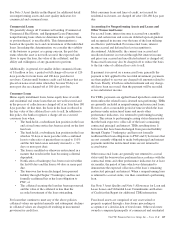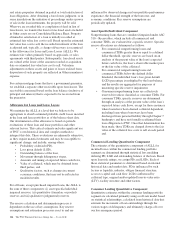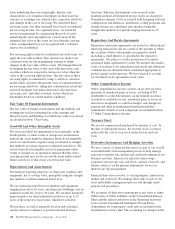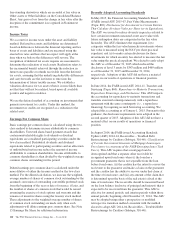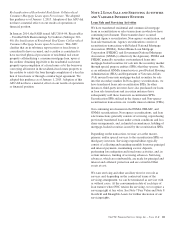PNC Bank 2015 Annual Report Download - page 134
Download and view the complete annual report
Please find page 134 of the 2015 PNC Bank annual report below. You can navigate through the pages in the report by either clicking on the pages listed below, or by using the keyword search tool below to find specific information within the annual report.
real estate properties obtained in partial or total satisfaction of
loan obligations. After obtaining a foreclosure judgment, or in
some jurisdictions the initiation of proceedings under a power
of sale in the loan instruments, the property will be sold.
When we are awarded title or completion of deed in lieu of
foreclosure, we transfer the loan to foreclosed assets included
in Other assets on our Consolidated Balance Sheet. Property
obtained in satisfaction of a loan is initially recorded at
estimated fair value less cost to sell. Based upon the estimated
fair value less cost to sell, the recorded investment of the loan
is adjusted and, typically, a charge-off/recovery is recognized
to the Allowance for Loan and Lease Losses (ALLL). We
estimate fair values primarily based on appraisals, or sales
agreements with third parties. Subsequently, foreclosed assets
are valued at the lower of the amount recorded at acquisition
date or estimated fair value less cost to sell. Valuation
adjustments on these assets and gains or losses realized from
disposition of such property are reflected in Other noninterest
expense.
For certain mortgage loans that have a government guarantee,
we establish a separate other receivable upon foreclosure. The
receivable is measured based on the loan balance (inclusive of
principal and interest) that is expected to be recovered from
the guarantor.
Allowance for Loan and Lease Losses
We maintain the ALLL at a level that we believe to be
appropriate to absorb estimated probable credit losses incurred
in the loan and lease portfolios as of the balance sheet date.
Our determination of the allowance is based on periodic
evaluations of these loan and lease portfolios and other
relevant factors. This critical estimate includes significant use
of PNC’s own historical data and complex methods to
interpret this data. These evaluations are inherently subjective,
as they require material estimates and may be susceptible to
significant change, and include, among others:
• Probability of default (PD),
• Loss given default (LGD),
• Outstanding balance of the loan,
• Movement through delinquency stages,
• Amounts and timing of expected future cash flows,
• Value of collateral, which may be obtained from
third parties, and
• Qualitative factors, such as changes in current
economic conditions, that may not be reflected in
modeled results.
For all loans, except purchased impaired loans, the ALLL is
the sum of three components: (i) asset specific/individual
impaired reserves, (ii) quantitative (formulaic or pooled)
reserves and (iii) qualitative (judgmental) reserves.
The reserve calculation and determination process is
dependent on the use of key assumptions. Key reserve
assumptions and estimation processes react to and are
influenced by observed changes in loan portfolio performance
experience, the financial strength of the borrower, and
economic conditions. Key reserve assumptions are
periodically updated.
Asset Specific/Individual Component
Nonperforming loans that are considered impaired under ASC
310 – Receivables, which include all commercial and
consumer TDRs, are evaluated for a specific reserve. Specific
reserve allocations are determined as follows:
• For commercial nonperforming loans and
commercial TDRs greater than or equal to a defined
dollar threshold, specific reserves are based on an
analysis of the present value of the loan’s expected
future cash flows, the loan’s observable market price
or the fair value of the collateral.
• For commercial nonperforming loans and
commercial TDRs below the defined dollar
threshold, the individual loan’s loss given default
(LGD) percentage is multiplied by the loan balance
and the results are aggregated for purposes of
measuring specific reserve impairment.
• Consumer nonperforming loans are collectively
reserved for unless classified as consumer TDRs. For
consumer TDRs, specific reserves are determined
through an analysis of the present value of the loan’s
expected future cash flows, except for those instances
where loans have been deemed collateral dependent,
including loans where borrowers have been
discharged from personal liability through Chapter 7
bankruptcy and have not formally reaffirmed their
loan obligations to PNC. Once that determination has
been made, those TDRs are charged down to the fair
value of the collateral less costs to sell at each period
end.
Commercial Lending Quantitative Component
The estimates of the quantitative component of ALLL for
incurred losses within the commercial lending portfolio
segment are determined through statistical loss modeling
utilizing PD, LGD and outstanding balance of the loan. Based
upon loan risk ratings, we assign PDs and LGDs. Each of
these statistical parameters is determined based on internal
historical data and market data. PD is influenced by such
factors as liquidity, industry, obligor financial structure,
access to capital and cash flow. LGD is influenced by
collateral type, original and/or updated loan-to-value ratio
(LTV), facility structure and other factors.
Consumer Lending Quantitative Component
Quantitative estimates within the consumer lending portfolio
segment are calculated primarily using a roll-rate model based
on statistical relationships, calculated from historical data that
estimate the movement of loan outstandings through the
various stages of delinquency and ultimately charge-off over
our loss emergence period.
116 The PNC Financial Services Group, Inc. – Form 10-K



